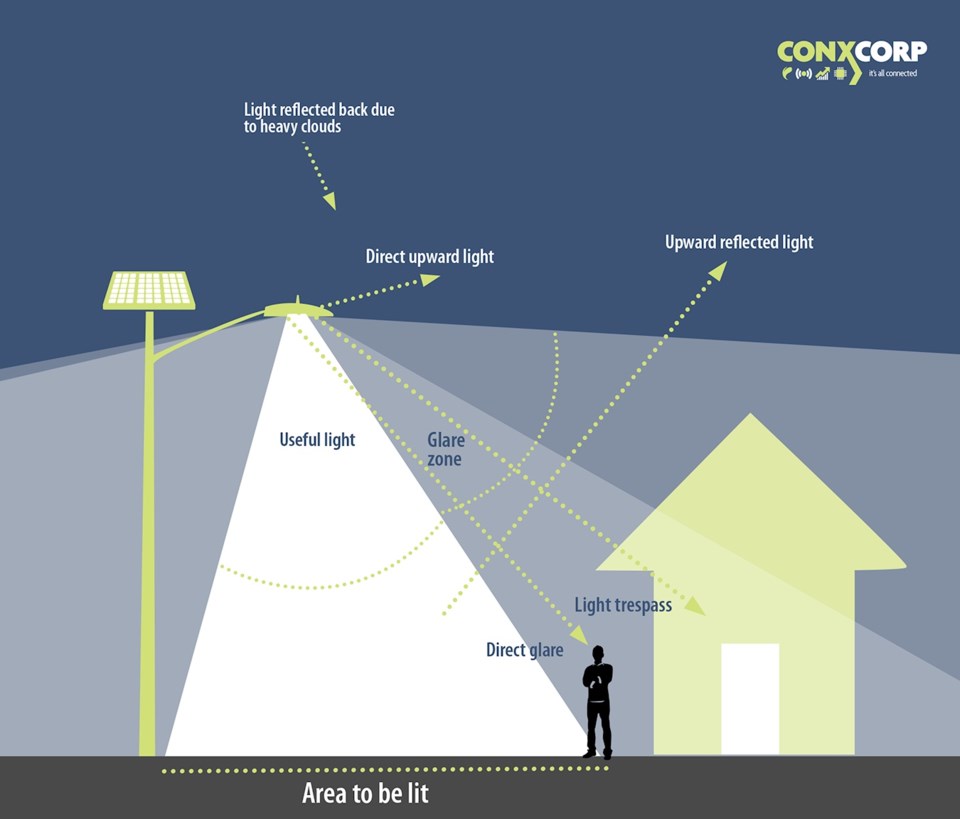Many of us don’t realize the effects we are having on our natural surroundings.
Last fall, Tri-City Greendrinks featured a lighting specialist and longtime member of the International Dark Sky Association (IDA), Brian Bury, to enlighten us about one of the least talked about forms of pollution.
Earth evolved with bright days and dark nights. All living things need the natural daily cycles of light and dark to survive and thrive. Thus, poorly designed artificial lighting after dusk can have myriad negative effects on living organisms, including plants, animals, invertebrates — even humans.
The American Medical Association states: “All creatures need darkness to survive.” Suppressing the production of melatonin can affect human health as this hormone has antioxidant properties, induces sleep, boosts the immune system, lowers cholesterol and helps the functioning of the thyroid, pancreas, ovaries, testes and adrenal glands.
The Journal of Epidemiology Research shows that exposure to artificial light at night has been linked to an increase in Alzheimer’s, breast cancer, obesity and depression.
Light pollution is excessive, obtrusive, misdirected artificial light at night that points outward and upward instead of downward.
Glare is excessive light that shines laterally, creating blind spots and unsafe conditions, while useful light focusses downwards, making the light more effective, efficient and safer.
Light pollution contributes to sky glow — the yellowish or hazy orange “fog” above a city — with the most significant source worldwide being streetlights.
The IDA estimates about 35% of all outdoor lighting in the U.S. alone is wasted by unshielded and/or poorly-aimed outdoor lighting. This equates to $3.3 billion and the release of 21 million tons of carbon dioxide per year. According to astronomer Diane Turnshek, light pollution is increasing currently at about 6% per year.
Glare can “blind” and create shadows, preventing a driver or pedestrian from seeing the road, pavement or another vehicle or person. Just as an oncoming car with its high-beams on disrupts and annoys an onlooker, so do many of our homes and buildings disrupt their surroundings. Having a light on does not necessarily make one safer; it’s all about the design of the light.
Many essential wildlife behaviours such as mating, migrating, navigating and foraging depend on the ability to experience natural darkness. As many as 30% of vertebrates and 60% of invertebrates are nocturnal, relying on night-time darkness to survive.
When I recently spoke with a Metro Vancouver employee to suggest the regional district install light shields at the Murray Street maintenance station, he shared that a Delta resident had reported a decrease in local frog-mating behaviour after the introduction of another Metro maintenance station’s lighting system.
Melissa Chaun of Port Moody is an ecologist with a passion for all things sustainable. She is events co-ordinator with the Rivershed Society of BC and volunteers on various city committees. Her column runs monthly.
••••••••
What we can do about light
Here’s how to combat light pollution:
1) Adopt Dark Sky-sensitive lighting that involves:
• shields at 45 degrees with lightbulbs set deep inside, allowing downward (unidirectional) lighting only;
• red or yellow colours — packaging for new CFL and LED light bulbs provide colour temperature information. Look for warm white sources with a colour temperature of 3000 Kelvin or lower. Their light is less harsh and less harmful to human health and the environment (blue light scatters more in the atmosphere, consequently, energy-conserving LED lights may actually prove harmful to living organisms);
• lower wattage bulbs, dimmers, timers and/or motion-sensors — along with focussing light downwards, this is how best to conserve energy.
2) Encourage your local government to adopt lighting ordinances that are Dark Sky-compatible.
3) Visit darksky.org for more information and consider donating to the IDA in support of its life-preserving work.
4) Finally, to minimize harm from blue light in your home, choose the right lightbulb and download a colour temperature app that adapts your electronic screen to the time of day — cool light during the day and warm light at night (see darksky.org).



